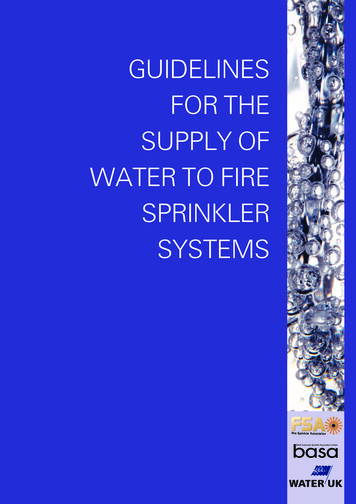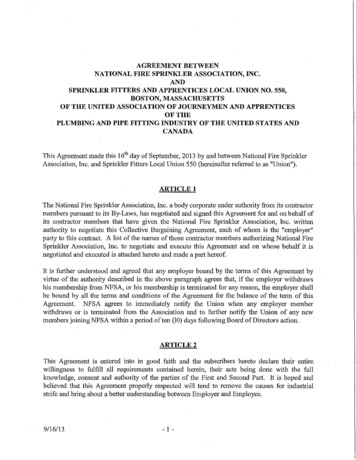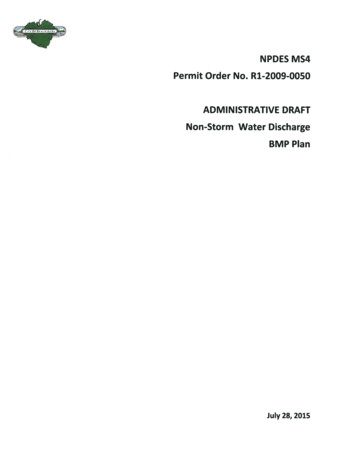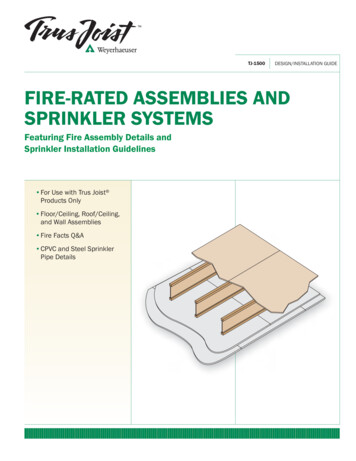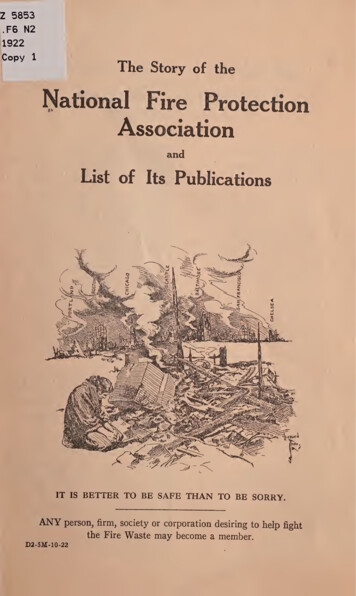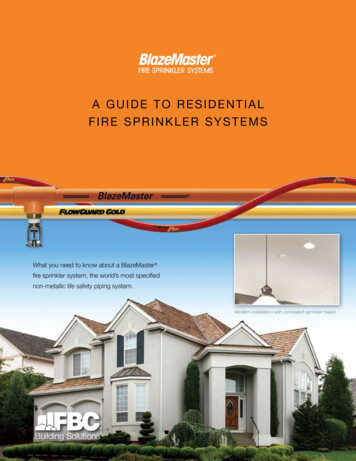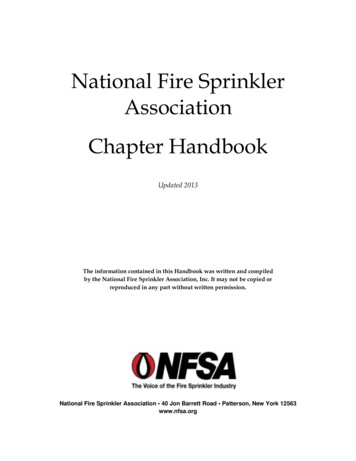
Transcription
National Fire SprinklerAssociationChapter HandbookUpdated 2013The information contained in this Handbook was written and compiledby the National Fire Sprinkler Association, Inc. It may not be copied orreproduced in any part without written permission.National Fire Sprinkler Association 40 Jon Barrett Road Patterson, New York 12563www.nfsa.org
TABLE OF CONTENTS1 – INTRODUCTION . 12 – ACKNOWLEDGEMENTS . 23 ‐ ABOUT THE NATIONAL FIRE SPRINKLER ASSOCIATION . 34 ‐ FROM THE NFSA PRESIDENT . 55 – BENEFITS OF FORMING A CHAPTER . 66 – WORKING WITH YOUR REGIONAL MANAGER AND AREA DIRECTOR . 77 ‐ FORMING A NEW CHAPTER . 88 ‐ OPTIONS AND LEGAL ISSUES IN CHAPTER STRUCTURES.109‐ CHAPTER FUNDING AND FINANCES .1210 ‐ CHAPTER OPERATIONS .1511 ‐ PLANNING AND CONDUCTING CHAPTER MEETINGS .1612 ‐ SUCCESSION PLANNING .17APPENDIX I‐ MODEL MEMORANDA OF UNDERSTANDING . IIAPPENDIX II – CODE OF ETHICS. XIVAPPENDIX III – MODEL BYLAWS. XVIAPPENDIX IV – CHAPTER LEADERSHIP JOB DESCRIPTIONS. XVIIAPPENDIX V – SAMPLE NOMINATION POLICY . XVIIIAPPENDIX VI ‐ SUGGESTED CHAPTER COMMITTEES . XIXAPPENDIX VII – CHAPTER MEETINGS . XXAPPENDIX VIII ‐ SAMPLE MEETING ANNOUNCEMENTS . XXIVAPPENDIX IX – MEETING MINUTES TEMPLATES . XXVIIAPPENDIX X ‐ ABOUT THE INDUSTRY PROMOTION FUND . XXIXAPPENDIX XI ‐ PETITION FOR CHAPTER RECOGNITION . XXX
1 – IntroductionThe purpose of this handbook is to provide guidelines for establishing, operating, and maintainingChapters of the National Fire Sprinkler Association.Many of the recommendations in this handbook are already being implemented; in fact, many of thesuggestions originated from longstanding Chapters. These existing Chapters may find this handbook willserve as “refresher.” In areas where Chapters are being reorganized or organized for the first time, thishandbook will provide the necessary assistance for getting started in the right direction.Chapter development at NFSA was formalized in 1990 when then‐Chairman of the Board, Kevin T. Fee,convened the first meeting of the NFSA's Regional Structure Evaluation Committee to evaluate theeffectiveness of NFSA at the local level and conceive of strategies to provide a more consistent approachto NFSA regional activities. This process resulted in the adoption of the original NFSA Chapter Handbookon January 1, 1991.By 2013, NFSA had an established network of Chapters in more than a dozen areas across the UnitedStates.With new Chapters in the development process and organizational changes throughout NFSA, an updateof the original handbook was necessary.As changes occur in the Association, this handbook will be updated periodically to reflect new conceptsand ideas. Please direct your suggestions to your NFSA Regional Manager or Area Director.Organization, planning, teamwork, and cooperation are essential to a well‐run Chapter. The intent is forthis handbook to be an important tool for you and the members of your Chapter.1
2 – AcknowledgementsMany of the documents and information contained in this handbook are the result of the hard work anddedication of current Chapter members and NFSA staff across the United States.The NFSA wishes to thank the original Regional Structure Evaluation Committee and the members of theNFSA Regional Operations team and NFSA staff members for the many hours and hard work indeveloping and updating this very important resource for NFSA Chapters across the nation.NFSA further wishes to thank the Regional Operations team who have taken on the challenge ofupdating this handbook to make it useful in today’s NFSA.Those who contributed to the update of this handbook included: Vice President of Regional Operations,Buddy Dewar, Associate Directors of Regional Operations Dominick Kasmauskas and Wayne Waggoner,Regional Managers Ray Lonabaugh, Suzanne Mayr, Lorrell Bush, Bob Kleinheinz, Tom Lia and BruceLecair as well as NFSA staff members Linda Daly, Jeannie Kozlowski, Fred Barall and Carla Gunther.A special thanks to Diana Romano for her historical knowledge and contributions to this revision.2
3 - About the National Fire Sprinkler AssociationAbout the AssociationEstablished in 1905, the National Fire Sprinkler Association, Inc. (NFSA) is a trade association that servesas the “Voice of the Fire Sprinkler Industry.” NFSA has a very broad‐based membership.Mission StatementTo protect lives and property from fire through the widespread acceptance of the fire sprinkler concept.PurposeTo provide a structured forum in which members: work together on local initiativessupport national issues consistent with the goals and objectives of the NFSApromote the acceptance of competently installed and maintained fire sprinklers andother fire suppression systems in both new and existing constructionuphold the highest standards of professionalismHow NFSA Serves MembersNFSA works on behalf of the fire sprinkler industry, lending technical expertise and representing theinterests of members and the fire sprinkler industry in order to impact the acceptance of competentlyinstalled water based fire protection systems in all occupancies.Membership TypesContractor – any firm or corporation that installs, maintains or repairs fire sprinkler systems in theUnited States.Manufacturer‐ any firm or corporation that manufactures and sells fire sprinkler devices in the UnitedStates.Supplier and Manufacturers– any person, firm, or corporation that manufactures, sells or distributesmaterials or services whose end use is intended for inclusion in fire sprinkler systems.Professional – architects and engineers and other professionals whose principal service is to theconstruction or fire protection industries.3
Subscriber – available to fire, building, insurance, and government officials, or any other person, firm,corporation, trade association or professional society not eligible for membership under the othercategories of membership.In addition, NFSA offers alliances with “Friends of the Industry,” such as homeowners’ associationmembers, political appointees, realtors and water industry members, who are not traditionallyconsidered part of the fire sprinkler industry.Membership Services representation on model building codes and national, state and local standards‐makingcommitteestechnical assistance available via phone or emailtraining materials and educational programs delivered in a variety of formatsnetwork of locally‐based Regional Managers for assistance with statewide and localissuespublications highlighting industry news, technical updates and featurespublic fire protection division whose focus is to build partnerships with national fireorganizations to promote sprinkler awareness and legislationmarketing, promotion and social mediaIn addition, labor relations are available in a separate division funded by Industry Promotion funds.Your local contact with NFSA is your Regional ManagerRegional Managers are located strategically across the United States and work to defend and maintainmarkets by providing assistance to local Chapters, implementing training, acting as liaison withAuthorities Having Jurisdiction (AHJs) and other organizations within the fire protection and buildingcommunity, monitoring and participating in local code and legislative activities and recruiting newmembers.For a map of NFSA areas and links to theRegional Managers, visit our website at:http://www.nfsa.org/?page regmap.4
4 - From the NFSA PresidentChapters and the NFSA,Local chapters are an important foundation for any national organization.They provide a source of energy, ideas and leadership.For the National Fire Sprinkler Association Chapters are even moreimportant, because the industry sits at the crossroads of the fire protectionand construction industries, and both of these industries are primarilyregulated at the state level. This means that there is often no “one size fits all” solution to an industryproblem or opportunity. Issues of licensing, code adoption, environmental regulation and standardsenforcement vary from state to state and even from city to city. Very often the best solution for onepart of the country is unworkable in another part of the country.This is where Chapters play a key role: to help decide the best course of action for the industry in aspecific area. NFSA is committed to the development of programs that are available for use when theymeet the needs of our local members.One of the greatest resources of the NFSA is our Regional Operations program, through which wemaintain a group of industry professionals that work to assist the Chapters in their local efforts. Thishandbook is the work product of our Regional Operations department, aimed at helping our membersorganize and operate NFSA Chapters. We hope that you will find it helpful, and that your Chapter canwork with the NFSA in its mission to advance the use of automatic fire sprinkler systems.Yours truly,Russell P. FlemingPresident5
5 – Benefits of Forming a ChapterThe National Fire Sprinkler Association has Chapters located in regions throughout the United Statesthat are all working toward our mission “to protect lives and property from fire through the widespreadacceptance of the fire sprinkler concept.” NFSA’s Chapter network not only provides access to localpeers but also to its nationwide peer network. As a member of a Chapter, you will have the opportunityto meet with other members of the fire sprinkler industry to discuss new and innovative ways toimprove and protect the industry as well as gaining new ideas to improving your company andprotecting your market share.Furthermore, as a Chapter member, you may have the opportunity to meet local government officialsand other industry stakeholders at regularly scheduled meetings with your peers. This provides a greatopportunity to provide feedback on local and statewide legislation, new technology and communicationas well as to discuss new and exciting ways to promote and maintain the fire sprinkler industry.Some additional benefits to forming a Chapter may include: Chapter meetings are a great forum to exchange ideas and identify key issues that needattention. Chapters may use a strategic planning process to identify and accomplish goals.Chapters provide an identity and are a greater voice when compared to individual companiesand organizations. Chapters are a focal point for legislators, media, and local authorities forpromoting the fire sprinkler industry. In many instances, Chapters meet to help identify localissues between AHJ and contractors to facilitate interaction and dialogue toward better codesand ordinances or to seek resolution on current regulations.Chapter members often work on statewide, local and NFSA committees, work groups, studygroups and task forces toward the goal of improved code development both locally, statewideand nationally.Chapters may have the ability to access funds to address business environment and industryissues.Chapter Board of Directors may be covered under insurance if they meet certain qualifications.Chapter members have membership benefits through NFSA that are offered only to Chapters asspecified by the Chapter memorandum of understanding, which may include access to training,engineering and legal resources applicable to Chapter formation issues.A Chapter and its membership may have access to industry updates and publications, techalerts, regional reports and direct access and assistance from NFSA staff members.NFSA Chapters agree to a strict code of ethics, which comes with positive industry recognitionand instant creditability.6
6 – Working with Your Regional Manager and AreaDirectorRegional OperationsThe mission of Regional Operations is to act as the eyes, ears and voice of the NFSA to promote the firesprinkler concept across the nation. Regional Operations strives to: Create new markets Protecting existing markets Address issues that affect business environment issues Recruit and retain new members Schedule seminarsRegional Managers serve the membership throughout the country, acting as the Chapter’s liaison for theNFSA national staff and may provide the local Chapter with assistance on problems and projects at thelocal level.An active Chapter working in tandem with its RegionalManagers is one of the most effective means ofpromoting interests of the fire sprinkler industry at thelocal level.More information and staff list can befound at:http://www.nfsa.org/?page regmapArea DirectorsIn addition to being served by Regional Managers, each of the NFSA Regions is represented by an AreaDirector elected by the contractor membership. The Area Director serves as a member of theContractors Council and Board of Directors. In addition to the 12 Area Directors, a Director at‐Largecategory has been established and a contractor member is elected by the Contractor’s membership toserve on the Contractors Council and Board of Directors.Chapter Chairmen are encouraged to work closely with their Area Director. Area Directors will solicitinput and suggested agenda items from Chapters for discussion at Contractors Council and Boardmeetings.Many Area Directors provide periodic updates of NFSA Board of Directors meetings and other activitiesaffecting the industry to the membership within their area at Chapter meetings and other plannedevents.7
7 - Forming a New ChapterThe process of forming a new Chapter requires organization and teamwork. Below are the steps tofollow once you have decided to start a new Chapter.Initial DecisionsOnce you have decided to start a new Chapter, there are some recommended decisions that your groupshould make in order to proceed with Chapter formation. If there are many individuals interested instarting a new Chapter, you may want to form an informal “organizing committee” that will be in chargeof making these decisions and taking care of the initial Chapter arrangements. This committee shoulddissolve once the Chapter is approved by the NFSA Board of Directors, in lieu of a Chapter board ofdirectors.Goals and Objectives ‐ Make a list of items you would like to accomplish as an NFSA Chapter. Theseitems may include such ideas as supporting local fire sprinkler legislation, providing local training events,etc. Please refer to the Chapter 8 for guidance on the actions that may be undertaken as a Chapter.Potential Membership List ‐ Think about who you would like to be involved in your Chapter. Chaptershave the same categories of and criteria for membership as the NFSA. Chapter members should also bemembers of NFSA, except that, as discussed below under “Start Up Period,” in the first two years after aChapter charter is granted, an NFSA Chapter may include both NFSA and non‐NFSA members.Legal Structure ‐ Chapter leaders have a lot of flexibility to determine the structure of their Chapters.Chapter leaders can decide whether or not to separately incorporate, whether to obtain a tax exemptstatus through a group exemption or on their own, and whether they would like to purchase their owninsurance policies or be covered by some NFSA insurance policies. Please refer to Chapter 8 for moreinformation about these options. The NFSA staff attorneys are happy to help Chapters should they havelegal questions relating to the formation of their Chapters.Funding Sources‐ Think about how you will fund Chapter activities. As detailed in Chapter 9, mostChapters raise money through Chapter dues, training events, or other fundraising campaigns. Pleaserefer to the section in Chapter 8 titled “Working within the 501(c)(6) Exemption,” for guidelines onfunding sources.Petition the NFSA Board of DirectorsOnce you and your group have thought about some of the logistics of starting a new Chapter, you maypetition the NFSA Board of Directors for recognition as a Chapter. A petition to the Board of Directorsshall include the following: Proposed Chapter name.Proposed Chapter territory.Agreement to adopt the applicable version of the standardized Chapter bylaws andMemorandum of Understanding (MOU), provided by NFSA, which best conform to the Chapter’sproposed structure.8
Affirmation that any Chapter policies or governing documents shall be in compliance with allNFSA policies, bylaws, and code of ethics.In addition, Chapters should attach to their petition form a copy of the MOU and bylaws that they haveadopted or intend to adopt.A copy of the petition form is available in Appendix XI. Model MOUs and model Chapter bylaws arelocated in Appendices I and III. Chapter bylaws and MOUs should be consistent with these models.Once the NFSA Board of Directors grants a charter to the Chapter, Chapter operations can begin. Thefirst order of business should be to elect directors and officers, as per the Chapter bylaws. See below forguidance on chapter governance during the chapter “start‐up period.”“Start‐Up Period”The Chapter “start‐up period” is two years from the date that the chapter’s charter is granted. Duringthis time, per approval of the Board of Directors, the NFSA “start up” Chapter may be organized withboth NFSA and non‐NFSA members. The Chapters may be supported by the NFSA Regional Manager andstaff and can be supported by Chapter dues from both NFSA and non‐NFSA members. Planning andconducting the Chapter will be in accordance with the NFSA Chapter Handbook.During the two year period, the “start‐up” Chapter members and their companies in good standing areeligible to receive partial benefits. Chapter members who are already members in good standing ofNFSA will continue to have access to all the membership benefits of NFSA. Chapter members who arenot current members of NFSA may request access to approved “start up” benefits from their localRegional Manager. Such benefits may include:‐‐‐Limited access to Expert of the Day (EOD) serviceNFSA newsletters and publicationsDiscounts on trainingPlease contact your Regional Manager with any questions about the "start‐up period."9
8 - Options and Legal Issues in Chapter StructuresChapter leaders have a lot of options to decide how they would like to structure Chapters. Below isinformation about the different ways Chapters can be structured, and how to go about achieving thesestructures.IncorporationSome Chapter leaders choose to incorporate their Chapters because it helps to protect them frompotential liability in the event of a lawsuit against a Chapter. In addition, Chapters that are incorporatedseparately from NFSA have greater freedom to conduct Chapter business with fewer requirements fromNFSA. Other Chapters choose to remain unincorporated associations, which saves those Chapters theadministrative and financial burden of filing for incorporation.A Chapter that chooses to incorporate separately should provide NFSA with a copy of its Articles ofIncorporation. Any amendments to Chapter Articles of Incorporation should be approved by the NFSABoard of Directors.While the process of incorporation varies by state, there are some common elements in most state laws.Generally, the Chapter Board of Directors files the articles of incorporation with the secretary of state inthe state in which they choose to incorporate. The articles of incorporation call for general informationabout the Chapter, such as the Chapter name, mission and activities. Most state laws also require theadoption of bylaws or other governing documents.Please contact the NFSA Legal Department or a private attorney for more specific information aboutincorporation, or for help in incorporating your Chapter.Tax‐Exempt StatusNFSA is a 501(c)(6) organization, meaning that it is exempt from some income taxes. Chapters can availthemselves of the NFSA 501(c)(6) status through a “group exemption,” or they can apply for a separatetax‐exempt status through the Internal Revenue Service.A “group exemption” is a determination by the IRS that the Chapters or affiliates of a nonprofitorganization are also tax exempt. If you would like your Chapter to be included in the NFSA groupexemption, please provide the following documentation to the NFSA Controller at NFSA Headquarters:(1) a letter, signed by your Chapter Chairman, authorizing NFSA to include your Chapter in the groupexemption, and (2) your federal Employer Identification Number (EIN) (see Chapter 9 of this Handbookfor more information about obtaining an EIN number). To remain a part of the group exemption, yourChapter should provide the NFSA Controller with information on an annual basis about your Chapter’soperations and programs, as detailed in Section IV, Paragraph B of the MOU.10
Insurance for ChaptersIt is important that Chapters are insured for their activities. Chapters may purchase their own insurancepolicies, or NFSA will work with your Chapter to help ensure that insurance policies are available.Working within the 501(c)(6) ExemptionWhether your Chapter has obtained a tax exempt status through the NFSA group exemption, or yourChapter has obtained its own 501(c)(6) exemption, the following guidelines will help you to conductyour Chapter activities in accordance with the applicable rules.Feel free to contact the NFSA legal department or a private attorney if you have any questions aboutthis information.Charitable Contributions ‐ Donors who contribute to a 501(c)(6) organization (including NFSA and itsChapters) cannot deduct the gift as a charitable contribution on their federal income tax returns.However, under some circumstances, these donors might be able to deduct such a gift as a trade orbusiness expense.Membership Criteria ‐ The government grants a 501(c)(6) exemption based on the understanding thatthe organization in question will work to benefit an industry or segment of an industry as a whole, andnot specific group members. In addition, antitrust laws target trade associations that have membershiprestrictions that could be seen as restraining trade. For these reasons, the model bylaws set Chaptermembership criteria that are consistent with those of NFSA (excluding the "start‐up period). In enforcingmembership policies, Chapters should be sure to grant membership to all applicants that are eligibleunder these criteria.Unrelated Business Income ‐ The 501(c)(6) exemption regulates the amount of income that is unrelatedto an organization’s exempt purpose. This means that only an “insubstantial” amount of Chapter incomeshould be unrelated to its exempt purpose of promoting the fire sprinkler industry.It is often difficult to tell whether some profits are “related” or “unrelated” to the exempt purposes of aChapter. Please contact the NFSA legal department or a private attorney for more information orquestions about unrelated business income or other aspects of the 501(c)(6) exemption.11
9- Chapter Funding and FinancesChapter FundingGeneral Funding for Chapter operations from NFSAChapter funding sources vary by region. Factors include membership, dues structure, market share,populations, and availability of Industry Promotion or Industry Advancement funds. Each Chaptershould develop a plan for funding depending on its local variables. Many Chapters are funded byChapter dues collected by both NFSA and non‐NFSA members during the “start‐up period.” Additionalfunding can be obtained from fundraising events such as golf outings, training events, etc.Industry Promotion FundsThe National Fire Sprinkler Association created the concept of Industry Promotion (IP) for the sprinklerindustry. Industry Promotions was ratified through Collective Bargaining Agreements beginning in 1985.Industry Promotion funds are not Taft‐Hartley funds under the Labor Management Relations Act.Industry Promotion Funds are administered by management trustees with goals and objectivesestablished by the trust agreement and implemented through consultation with local contractoradvisory committees.There are three designated “Trustees” who have fiduciary responsibility for the oversight of the variousIndustry Promotion programs and their finances. The Trustees consist of the President of NFSA, NFSA’sSenior Vice President of Industrial Relations and General Counsel, and the Vice President of IndustrialRelations and Corporation Counsel. IP funds are not co‐mingled with NFSA funds. The trust agreementhas been reviewed by outside counsel and has received approval as a “not‐for‐profit” entity underSection 501(c)(6) of the Internal Revenue Code.IP funds are primarily used for educational programs such as seminars, workshops and development ofthe fire sprinkler market. Industry Promotion Funds have also been utilized for legislation when the useof funds are consistent with the overall objective to “create a market for the widespread acceptance ofcompetently installed automatic fire sprinkler systems in both new and existing construction homes tohigh‐rise.” As specified in the agreement, monies collected as part of an Industry Promotion fundinitiative must be used in the territory of the collective bargaining agreement (see About IndustryPromotion in Appendix X).Industry Advancement FundsNFSA Board of Directors created the Industry Advancement Fund to allow open shop contractors tosupport the advancement of the fire sprinkler industry on a voluntary basis. Support through the IAF is12
strictly voluntary. Donations are not deductible on federal income tax returns as charitablecontributions, but in some circumstances, could be deductible as trade or business expenses.Chapter Finances and RecordsTax Identification NumberChapters will need their own Employer Identification Numbers (EIN) to open bank accounts in the nameof the Chapter and to obtain tax exempt status on their own or through a group exemption. An EINnumber is a nine‐digit number assigned by the IRS to identify the Chapter, much like a social securitynumber.EIN numbers are issued by the IRS and can beobtained through the IRS website.Pleasecontact the NFSA Accounting Department forhelp if needed.EIN numbers can be requested at thefollowing l/index.jsp.Regardless of whether a Chapter has an EINnumber, it still has the option of allowing NFSA tocompile its tax information through a groupreturn, or it can file its own taxes as a separate entity. See below for more information about theseoptions. For more information on the NFSA group tax exemption, please refer to Chapter 8 of thisHandbook.Tax ReturnsChapters have the option of filing their own tax returns with the IRS, or allowing NFSA to file tax returnson its behalf, through a “group return.”Group ReturnChapters that choose to permit NFSA to file tax returns on their behalf should obtain an accountingsoftware product such as QuickBooks. This will enable the transfer of financial information to NFSA viaemail if desired.In addition, Chapters should provide the NFSA Controller with the following information by the end ofthe succeeding month following the end of each calendar quarter (i.e., by April 30th for the quarterending March 31): A quarterly Balance Sheet, Statement of Activities (Income Statement) and Cash FlowStatement. All of this information is available within the QuickBooks accounting program.Copies of the check register, trial balance, monthly bank statements, bank reconciliations andexpense receipts (for items over 20.00).Copies of the Chapter’s Annual Budget should also be forwarded to the NFSA Controller uponcompletion.13
Separate Tax ReturnsChapters that choose to file separate tax returns should forward copies of these returns to NFSA upontheir completion.Chapter RecordsAll Chapters should keep NFSA apprised of their programs and activities. At the start of each calendaryear, please provide the NFSA Controller or Legal Department with the foll
National Fire Sprinkler Association Chapter Handbook Updated 2013 The information contained in this Handbook was written and compiled by the National Fire Sprinkler Association, Inc. It may not be copied or reproduced in any part without written permission. National Fire Sprinkler Association 40 Jon Barrett Road Patterson, New York 12563
